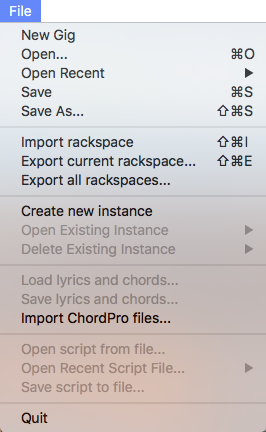
Clears all memory and opens a new rackspace with all default values.
Opens a saved .gig file.
Provides a popup menu listing the five most recent .gig files.
Saves your work in a .gig file.
Saves your work in a .gig file but allows you to enter a new name first (thus preventing previously saved .gig files from being overwritten).
Allows you to import a single rackspace from a list of previously exported rackspaces. The newly imported rackspace is simply added to your currently created rackspaces—it does not overwrite or delete any of your work. Note that you can also drag and drop one or more rackspaces from a folder directly into Gig Performer, making it fast and easy to create a complete new setlist from existing rackspaces.
Allows you to export a single rackspace for use in another Gig Performer project.
Allows you to export all rackspaces for use in another Gig Performer project.
(Note: The following three menu items appear only when the “Enable multi-instance support” option is checked in the Advanced tab of the Preferences dialog.)
Allows you to create a new instance. (For more information click here.)
A popup menu allows you to open a previously created and saved instance. (For more information click here.)
A popup menu allows you to delete a previously created and saved instance. (For more information click here.)
When the song lyrics/chords editor window is open, this command is active, and allows opening ChordPro files from the root directory specified in the Options>Setlist tab of the Options dialog.

–When the song lyrics/chords editor window is open, this command is active, and saves the contents of the Song Lyrics/Chords Editor as a .gpchord file. The default directory for these documents is the root directory specified in the Setlist/Song Settings tab of the Options dialog
–This command copies a selected ChordPro file to the ChordPro documents root directory specified in the Setlist/Song Settings tab of the Options dialog and then opens it in the Song Lyrics/Chords editor. It is only active when Gig Performer is showing the setlist view.
Choosing the command brings up a standard Open File dialog for you to navigate to and select a script to open. Click for more information on GP Script.
A popup submenu lists all GP script files that have been worked on recently. Select one to open. Click for more information on GP Script.
Saves a GP script you have been working on to a new file. Click for more information on GP Script.
Quit Gig Performer. If you have any unsaved work, a dialog will ask you if you want to save your data first.